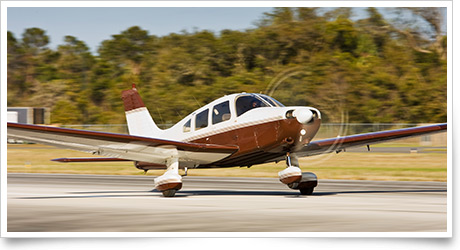Apr. 19, 2013, issue of 'AOPA ePilot: Flight Training Edition' weekly newsletter
| ||||||
| Takeoff power or ‘Take off power!’? |
| |||||
Training TipsTakeoff power or ‘Take off power!’?
Preflight inspection completed, you attach the towbar to the nose strut and ease the airplane from its tiedown spot, stopping well away from neighboring aircraft for engine start.
Pre-takeoff checks are good and the engine runup is perfect. So you scan for traffic and announce your intention to remain in closed traffic, and taxi out for takeoff.
Lined up on the centerline of the 3,000-foot runway, you gradually advance the throttle, adding right rudder to maintain a straight track as the aircraft accelerates. You can feel the control surfaces coming alive as you take a quick glance at the oil-pressure gauge, and then look to the airspeed indicator.
At 55 knots you will rotate, and when airborne, accelerate to V Y, 79 knots.
What’s this? Despite what you see outside and what you feel through the yoke and pedals, the airspeed indicator appears to be broken—it’s not “coming alive” as it has on previous flights.
Instinctively you give the throttle an extra push—but it’s already full forward. Carburetor heat? Off. Magnetos? Set on “both.”
This is confusing! The airplane seems ready to fly. But wouldn’t it be better to abort the takeoff—not something you have practiced much—and find out what’s going on here? The midpoint of the runway is drawing near. What to do? All questions, no time.
That classic taildragger is somewhere in the pattern; now the thought strikes you that you looked over to admire it just before you went to remove the cover from the pitot tube beneath the airplane’s left wing. Did you remove it?
Just as the nosewheel is lifting off, you idle the throttle to abort takeoff while there’s still plenty of runway ahead, heaving a sigh of relief as the airplane starts to decelerate without the need for serious braking. As you taxi back to your tiedown spot to check the pitot tube cover, you make a mental note of the importance of closely following checklists and limiting distractions during preflight. Flight Training NewsTake a sneak peek at ‘CFI to CFI’ free digital newsletterWhether you’re an active CFI or getting back into instructing, the Air Safety Institute recommends you check out its free CFI to CFI newsletter. Optimized for the PC and digital tablets, the current issue is packed with thought-provoking articles and videos, tips from fellow CFIs, and safety quizzes and courses to share with your students. You can also browse archived newsletter editions when you click “More Options” in the toolbar. Sign up now for your free quarterly CFI to CFI newsletter. .ebCirrus offers pilots to go with its aircraftCirrus Aircraft owners need not do the flying themselves, thanks to Cirrus On Demand, which allows customers to purchase what amounts to a personal flight department with their SR20 or SR22. Cirrus Aircraft is reviving a program that promises new pilot jobs, and ease of aviation for customers unable or uninterested in being pilots themselves. Read more >> Zulu finding success in retail flight trainingLast year an unlikely company unveiled an unlikely flight school. Headquartered in a retail strip mall location, Zulu Flight Training is owned and operated by Continental Motors, and based on the school’s initial results, it seems as though an engine manufacturer can effectively run a flight school. Read more >> JetBlue flies students to Sun ’n FunMore than 75 students from New York and Florida received the trip of a lifetime on April 11 when a JetBlue Airways Airbus A320 picked them up and flew them to Lakeland, Fla., for the thirty-ninth annual Sun ’n Fun International Fly-In & Expo. David “Scott” Malcomb, an instructor at JetBlue University College of Technical Operations, pitched the idea to his airline. Read more >> Poll probes students' flight training experiencesAOPA announced an online poll April 10 that will be the basis for its 2013 Flight Training Excellence Awards. “Our awards program, and this unique pilot poll, will give people a great opportunity to share feedback on their flight training experiences,” said Shannon Yeager, vice president of AOPA’s Center to Advance the Pilot Community. Read more >> CAE Academy buying 35 Piper trainersCAE Oxford Aviation Academy will add 35 Piper training aircraft to its fleet, CAE and Piper Aircraft Inc. announced in Lakeland, Fla., April 9. The agreement includes firm orders for 22 single-engine Archer TX and 13 twin-engine trainers, as well as parts and service. Deliveries will begin this spring, with 27 new airplanes going to CAE Oxford Aviation Academy in Phoenix; the remaining eight will be sent later in the year to CAE Oxford Aviation Academy in Oxford, United Kingdom. Read more >> Apps aid flight planning processYou can’t fly anywhere without proper flight planning. Smartphone and tablet apps have simplified the process, covering everything from flight calculators to wind computers. Check out five apps that help pilots with flight planning. Read more >> Students explore aviation careers at Van Nuys AirportMore than 1,400 high school students, 40 exhibitors, and an array of static aircraft participated in the eighth annual The Sky’s the Limit: Aviation Career Day hosted by MP Aero, Van Nuys Airport, and The Valley Economic Alliance on April 5. Students went on airport tours, played with interactive exhibits, and saw an aircraft display that included the Cirrus VK-30. Moving up to bigger and better aircraftStepping up from a 180-horsepower trainer to a bigger, faster aircraft can be a little intimidating. New systems and cockpit controls are there to greet you, and if you don’t know how, or when, to use them, it can be easy to fall behind the airplane quickly. Understanding what each system does goes a long way toward incorporating it into your normal flying duties. Take the Air Safety Institute’s Transitioning to High Performance/Complex Aircraft safety quiz now and get a head start on mastering these new concepts. Take the quiz >> Training Resources‘Flight Training’ offers virtual flight bagFlight Training magazine’s virtual flight bag is a handy reference to a variety of online tools that will greatly enhance your flight-planning experience—and you can access it from any personal computer connected to the Internet. Obtain airport information, access frequently used forms and contact information for FAA facilities, or try AOPA’s feature-filled online flight planner.
Did you know that student pilots who join AOPA are three times more likely to complete their flight training? Membership includes unlimited access to aviation information by phone (800/USA-AOPA, weekdays from 8:30 a.m. to 8 p.m. Eastern time) or from Flight Training Online or AOPA Online. If you’re not already a member, join today and get the pilot’s edge. Login information is available online. Special issuance changes, Sun ’n Fun recapIf you weren’t able to make it to the Sun ’n Fun International Fly-in & Expo, find out what you missed. Rod Machado’s latest “License to Learn” puts you in the cockpit for a lesson in density altitude. AOPA President Craig Fuller explains how a proposal that could keep pilots flying longer is losing traction at the FAA. Plus, find out how changes to the special issuance process could benefit pilots with medical conditions such as arthritis, asthma, hypertension, migraines, and renal cancer. AOPA Live This Week, April 18. Career PilotAmerican adopts Airbus overrun prevention systemAmerican Airlines has decided to equip all of its A320-family jets with Airbus’ new Runway Overrun Prevention System (ROPS) technology. This onboard cockpit technology, which Airbus has developed independently over several years, increases pilots’ situational awareness during landing, reduces exposure to runway excursion risk, and provides active protection if necessary. The system computes minimum realistic landing and ground stopping distances while comparing them to available landing distances in real time, considering such factors as runway topography, runway condition, aircraft weight and configuration, wind, and temperature. FedEx replacing 727s with secondhand twinjetsFedEx Corp. will buy 14 Boeing 757 passenger jets from United Continental Holdings Inc., with an option to buy another 16, and convert them to carry freight, according to a March 21 regulatory filing reported by Bloomberg. FedEx began buying used 757s six years ago; one of the jets can carry 20 percent more cargo than a Boeing 727 while burning one-third less fuel. Passenger airlines are beginning to sell off the narrowbody twinjets, which Boeing stopped building in 2005. FedEx also has 70 new Boeing 767s and 777s on order, Bloomberg reported.
For more aviation career news, see the Flight Training website. Plane Spotter | ||||||||||||||||||||||||||||||||||||
| |||
AVIATION EVENTS & WEATHER
| To include an event or to search all events in the calendar, visit AOPA Online. For airport details, including FBO fuel prices, see AOPA Airports. | ||||||||||||||
Final Exam
Question: What is the difference between night time and being able to log night time for the purposes of 14 CFR 61.57 night currency?
Answer: 14 CFR Definitions and Abbreviations defines night time as “the time between the end of evening civil twilight and the beginning of morning civil twilight, as published in the American Air Almanac, converted to local time.” The FAA defines night differently for night currency in 14 CFR 61.57(b), which says that in order to act as pilot in command of an aircraft carrying passengers during the time period starting at one hour after sunset to one hour before sunrise, a pilot must have completed three takeoffs and three landings to a full stop in the preceding 90 days during the period from one hour after sunset to one hour before sunrise. Although evening civil twilight and morning civil twilight may be dark, this doesn’t mean you can use takeoffs and landings flown during that time toward night currency. As the weather warms up and you find yourself wanting to fly into the evening, take a look at AOPA’s subject report on night flying for other questions you might have. Got a question for our technical services staff? Email [email protected] or call the Pilot Information Center, 800/872-2672. Don’t forget the online archive of “Final Exam” questions and answers, searchable by keyword or topic. Instrument Tip | ||||||||||||||
Flight Instructor Refresher Clinics | Air Safety Institute Safety Seminars | |||||||||
For a complete schedule, see AOPA Online. Can’t make it in person? Sign up for the CFI Refresher Online. |
Topics vary—for details and a complete schedule, see AOPA Online. | |||||||||
| | ||||
| ePilot Flight Training Editor: ePilot Editor: | Contributors: | | Production Team: | Advertise in ePilot: |
| Member Tools: Send feedback| ePilot Archive Got news or questions? Contact ePilot. Having difficulty using this service? Visit the ePilot Frequently Asked Questions online at AOPA.org or email us. | ||||




 It’s a great day for some solo takeoffs and landings. Traffic is light, and so are the winds as
It’s a great day for some solo takeoffs and landings. Traffic is light, and so are the winds as 



